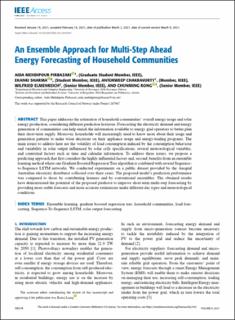| dc.contributor.author | Mehdipourpirbazari, Aida | |
| dc.contributor.author | Sharma, Ekanki | |
| dc.contributor.author | Chakravorty, Antorweep | |
| dc.contributor.author | Elmenreich, Wilfreid | |
| dc.contributor.author | Chunming, Rong | |
| dc.date.accessioned | 2023-02-21T08:16:58Z | |
| dc.date.available | 2023-02-21T08:16:58Z | |
| dc.date.created | 2021-04-29T13:49:48Z | |
| dc.date.issued | 2021 | |
| dc.identifier.citation | Pirbazari, A. M., Sharma, E., Chakravorty, A., Elmenreich, W., & Rong, C. (2021). An ensemble approach for multi-step ahead energy forecasting of household communities. IEEE Access, 9, 36218-36240. | en_US |
| dc.identifier.issn | 2169-3536 | |
| dc.identifier.uri | https://hdl.handle.net/11250/3052547 | |
| dc.description.abstract | This paper addresses the estimation of household communities' overall energy usage and solar energy production, considering different prediction horizons. Forecasting the electricity demand and energy generation of communities can help enrich the information available to energy grid operators to better plan their short-term supply. Moreover, households will increasingly need to know more about their usage and generation patterns to make wiser decisions on their appliance usage and energy-trading programs. The main issues to address here are the volatility of load consumption induced by the consumption behaviour and variability in solar output influenced by solar cells specifications, several meteorological variables, and contextual factors such as time and calendar information. To address these issues, we propose a predicting approach that first considers the highly influential factors and, second, benefits from an ensemble learning method where one Gradient Boosted Regression Tree algorithm is combined with several Sequence-to-Sequence LSTM networks. We conducted experiments on a public dataset provided by the Ausgrid Australian electricity distributor collected over three years. The proposed model's prediction performance was compared to those by contributing learners and by conventional ensembles. The obtained results have demonstrated the potential of the proposed predictor to improve short-term multi-step forecasting by providing more stable forecasts and more accurate estimations under different day types and meteorological conditions | en_US |
| dc.language.iso | eng | en_US |
| dc.publisher | IEEE | en_US |
| dc.rights | Navngivelse 4.0 Internasjonal | * |
| dc.rights.uri | http://creativecommons.org/licenses/by/4.0/deed.no | * |
| dc.title | An Ensemble Approach for Multi-Step Ahead Energy Forecasting of Household Communities | en_US |
| dc.type | Peer reviewed | en_US |
| dc.type | Journal article | en_US |
| dc.description.version | publishedVersion | en_US |
| dc.rights.holder | The authors | en_US |
| dc.subject.nsi | VDP::Teknologi: 500 | en_US |
| dc.source.pagenumber | 36218-36240 | en_US |
| dc.source.volume | 9 | en_US |
| dc.source.journal | IEEE Access | en_US |
| dc.identifier.doi | 10.1109/ACCESS.2021.3063066 | |
| dc.identifier.cristin | 1907236 | |
| cristin.ispublished | true | |
| cristin.fulltext | original | |
| cristin.qualitycode | 1 | |

